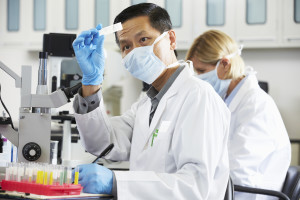All the World Is a Lab to the Inquiring Mind
in Research

 Pens, crayons, three-subject notebooks—all familiar items on rosters of back-to-school supplies. But JDRF’s list includes things you can’t find at your local big box store, like osmotic pumps, ELISA test kits and training courses in confocal microscopy. Those are some of the purchases we made this year to support an elite group of young scholars beginning work in university and hospital labs here and abroad: JDRF’s Class of 2016 Postdoctoral and Advanced Postdoctoral Fellows.
Pens, crayons, three-subject notebooks—all familiar items on rosters of back-to-school supplies. But JDRF’s list includes things you can’t find at your local big box store, like osmotic pumps, ELISA test kits and training courses in confocal microscopy. Those are some of the purchases we made this year to support an elite group of young scholars beginning work in university and hospital labs here and abroad: JDRF’s Class of 2016 Postdoctoral and Advanced Postdoctoral Fellows.
The JDRF Fellows are some of the most innovative young researchers in the world. They come from nations around the globe, including the U.S., Australia, China, Russia, France and Japan, and have backgrounds in subjects as diverse as polymer chemistry, cellular biology, biomedical engineering and clinical medicine. All of them are focused on the same goal as JDRF and our supporters: improving the quality of life and achieving a cure for people with type 1 diabetes (T1D).
The awards JDRF makes to the Fellows account for less than three percent of our total research funding commitment, but the investments we make in their work today could yield enormous, life-changing dividends for people with T1D. The Fellows, under the mentorship of some of the world’s leading T1D scientists, are working on projects to develop therapies to cure, prevent and treat T1D and its complications. For example:
- At the Baker IDI Heart and Diabetes Institute in Melbourne, Australia, Postdoctoral Fellow Bryna Chow, Ph.D., is exploring whether a newly discovered compound can prevent or even reverse the inflammation and scarring that leads to T1D-associated kidney disease.
- At Oregon State, Postdoctoral Fellow Xiaosong Du, Ph.D., is working to develop a combined glucose-sensing and hormone infusion catheter for use with an artificial pancreas system. The outer wall of the catheter will be studded with sensors that measure not only glucose levels, but also temperature and pulse. Data obtained from the catheter will be analyzed by an advanced algorithm to calibrate optimal doses of insulin as needed.
- At the University of Florida, Postdoctoral Fellow Dimitri Van Simaeys, Ph.D., is working to create a hybrid molecule that will infiltrate newly transplanted islets without causing an immune reaction to help a protein produced in the cells there prevent a mass cell death that often causes transplants to fail.
- At the University of Queensland in Brisbane, Australia, Postdoctoral Fellow Jane Mullaney, Ph.D., is trying to definitively link changes in the population of bacteria living inside the intestines—known as the microbiome—to immune responses to those changes and the subsequent onset of T1D. Establishing such a link could lead to potential prevention or treatment therapies and help predict who could develop T1D in the future.
What’s Next?
JDRF will continue to develop the next generation of T1D researchers at every stage of their careers. While we and the T1D community benefit from the Fellows’ diverse backgrounds, novel approaches and fresh ideas, the Fellows benefit from the professional networking and collaborative research opportunities we offer our funded scientists.
Why It Matters
Type 1 diabetes is a complicated disease, and JDRF is investing in many different therapies and technologies in order to better understand, treat and ultimately eliminate it. We believe that identifying the most promising young scholars across an array of disciplines, recruiting them to work in the T1D space and supporting and developing their careers will speed our progress toward the day when we finally Turn Type One into Type None.